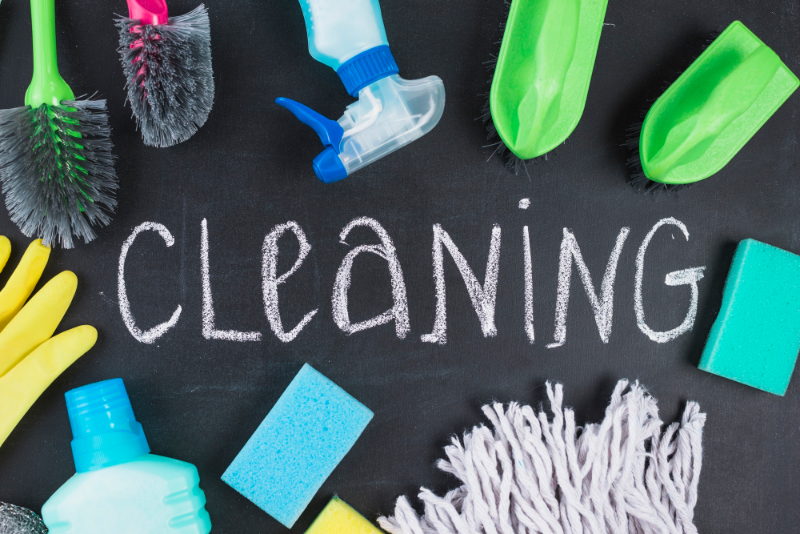Necessary Tips for Everyday Cleaning: Exactly How to Defrosted and Cleaned Every Few Months for a Fresh Property
Necessary Tips for Everyday Cleaning: Exactly How to Defrosted and Cleaned Every Few Months for a Fresh Property
Blog Article
Recognizing the Requirement for Extensively Disinfecting and Disinfecting Frequently Touched Surfaces in High-Traffic Locations
In the world of public wellness and security, the careful sanitation and sanitization of frequently touched surfaces in high-traffic locations stand as extremely important actions in preventing the spread of harmful pathogens. By discovering the numerous aspects of surface disinfection, from the risks linked with disregarding cleansing procedures to the effective methods that can be used, a more clear understanding emerges of the essential duty these methods play in protecting public health.
Importance of Surface Area Disinfection
Emphasizing the detailed sanitation of high-traffic surfaces is critical in preserving a hygienic setting and avoiding the spread of hazardous virus. High-touch surfaces such as door handles, light buttons, elevator switches, and countertops function as breeding grounds for viruses and germs. Regular sanitation of these surfaces is necessary to minimize the risk of contamination and transmission of health problems.
By executing a durable disinfection procedure, establishments and organizations can produce a more secure environment for staff members, site visitors, and clients. Proper surface sanitation not just mitigates the spread of contagious illness yet also imparts self-confidence in the sanitation and safety of the premises. This positive technique shows a commitment to health and wellness, which is especially crucial in high-traffic locations where the likelihood of exposure to pathogens is increased.
Furthermore, surface area sanitation plays a crucial role in overall infection control techniques. Integrated with hand health methods, using masks, and keeping physical distancing, detailed sanitation of high-touch surface areas creates a thorough protection versus the transmission of unsafe microbes. Focusing on surface area sanitation is an essential element of an alternative technique to health and wellness in shared areas.
Risks of Neglecting Cleaning Practices
Disregarding thorough sanitation of high-traffic surface areas substantially increases the risk of microbial and viral contamination, posing a severe danger to the health and wellness of individuals often visiting these rooms. Failing to carry out appropriate cleaning techniques can lead to the accumulation and spread of dangerous virus, including infections and germs, on frequently touched surface areas such as doorknobs, handrails, lift switches, and countertops.

Additionally, ignoring the relevance of complete cleaning not just jeopardizes the health of individuals but likewise undermines initiatives to maintain a hygienic and tidy environment. It is vital to recognize the value of proper sanitation protocols in protecting against the spread of infections and protecting public wellness.
Efficient Sanitation Methods
To preserve optimal tidiness and lower the risk of contamination on high-traffic surfaces, using effective disinfection approaches is important. Among one of the most common and effective disinfection approaches is using chemical disinfectants. These items can differ in strength and composition, with some targeting certain virus like viruses or germs. It is critical to follow the producer's guidelines for correct dilution, contact time, and ventilation when utilizing chemical anti-bacterials to guarantee their performance - defrosted and cleaned every few months.
An additional reliable approach is using UV-C light. UV-C light has actually been revealed to be efficient in eliminating a large array of microorganisms by disrupting their DNA framework, hence stopping them from reproducing. Nonetheless, it is crucial to make use of UV-C light effectively, making certain that the right strength and exposure time are applied to achieve the preferred disinfection outcomes.
Furthermore, read this post here utilizing vapor cleaning as a disinfection technique can be very efficient, specifically on surface areas that are heat-resistant. Heavy steam can penetrate permeable surfaces and kill germs, infections, and various other microorganisms properly. When using steam cleansing, it is necessary to make sure that the surface gets to the needed temperature level for an enough quantity of time to guarantee proper sanitation.
Effect on Public Health And Wellness
The upkeep of high criteria of cleanliness and disinfection on high-traffic surface areas plays an essential function in protecting public wellness. Often touched surface official statement areas in areas with high step, such as doorknobs, handrails, elevator switches, and toilet facilities, offer as reproducing grounds for damaging virus.
Effective hygiene practices not only shield people from falling ill however also add to the general health of society. Public health and wellness authorities emphasize the relevance of preserving tidy environments to stop outbreaks and contain the spread of illnesses. In high-traffic areas like airports, colleges, healthcare facilities, and public transportation systems, the influence of rigorous sanitation measures can not be downplayed. Prioritizing the sanitization of often touched surface areas is a positive method to advertising public wellness and enhancing the safety of individuals in shared areas.
Executing Regular Cleaning Up Procedures
Promptly instituting and adhering to a constant routine of cleansing protocols is vital for preserving the cleanliness and security of high-traffic surfaces. Normal cleaning protocols are important in preventing the accumulation of germs and virus on frequently touched surfaces, particularly in locations with high foot web traffic. By applying an organized approach to cleaning, organizations can properly decrease the threat of disease transmission and develop a much healthier setting for workers, consumers, and the general public.
To establish an effective cleaning schedule, it is important to identify high-traffic locations that need constant focus. These areas may include doorknobs, hand rails, elevator buttons, washroom centers, and shared devices. Applying a regular cleansing routine that targets these surface areas numerous times a day can significantly reduce the spread of harmful microorganisms and viruses.
Furthermore, using ideal cleaner and disinfectants is vital to making certain that surface areas are extensively sanitized. Regular training of cleansing staff on proper cleansing methods and the value of adherence to the cleaning routine is likewise essential in keeping a hygienic setting. By focusing on regular cleaning protocols, organizations can advertise the wellness and wellness of people who communicate with these high-traffic surfaces.

Conclusion
In verdict, it is vital to prioritize extensive sanitation and sanitization of frequently touched surface areas in high-traffic areas to protect against the spread of dangerous microorganisms and keep public health. It is essential to acknowledge the importance of maintaining clean surfaces in high-traffic areas to make sure the well-being of the neighborhood.
In the world of public health and security, the careful sanitation and sanitization of regularly touched surface areas in high-traffic areas stand official source as vital steps in preventing the spread of damaging pathogens. By discovering the different aspects of surface disinfection, from the risks associated with overlooking cleaning procedures to the reliable approaches that can be utilized, a clearer understanding emerges of the essential duty these methods play in securing public health and wellness.Additionally, using heavy steam cleansing as a disinfection technique can be very efficient, specifically on surface areas that are heat-resistant. When making use of heavy steam cleaning, it is important to ensure that the surface area reaches the required temperature level for an enough quantity of time to guarantee proper disinfection.
In verdict, it is vital to focus on detailed disinfection and sanitization of often touched surfaces in high-traffic locations to stop the spread of damaging pathogens and preserve public health and wellness.
Report this page